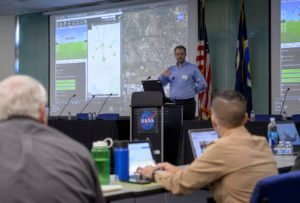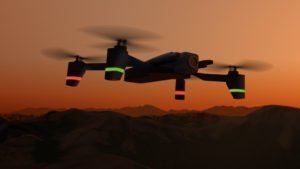By DRONELIFE Staff Writer Jim Magill
As emergency managers readily adopt the use of drones to aid in the response to natural disasters such as wildfires and hurricanes, the skies above those disaster zones are becoming increasingly crowded with aerial vehicles, both manned and unmanned, creating the need for an automated aerial traffic cop.
Enter NASA, whose Ames Research Center in California’s Silicon Valley is leading the way, with the development of the Scalable Traffic Management for Emergency Response Operations, or STEReO project. Working in collaboration with other federal agencies, state and local emergency management agencies and private companies, the two-year project aims to develop a system where drones, some flying autonomously, can automatically report important data — such as the UAV’s identity, spatial location, mission and flight path – to the disaster management team.
STEReO is an outgrowth of NASA’s multi-year Unmanned Aircraft System Traffic Management (UTM) project to develop a next-generation air traffic management system, to accommodate the increasing number of drones sharing the skies with manned planes and helicopters.
“If we think about a future where there’s a lot of UAS vehicles operating in low-altitude airspace, it’s going to be difficult to manage through traditional air traffic control resources. Today’s air traffic systems for commercial aviation and general aviation wouldn’t be able to scale to the high demand,” Joey Mercer, research psychologist in NASA’s Human Systems Integration Division, said in an interview.
Taking that basic concept of the UTM program, “we’d like to explore how those type of services can be applied to emergency response,” said Mercer, a principal in the development of the STEReO project.
The project developers plan to conduct two demonstrations of the emergency response traffic management system. The first, a live flight demonstration, which will show the use of the system in the battle against wildfires, will be conducted next spring, likely in conjunction with a previously scheduled event sponsored by a STEReO partner such as Cal Fire or the US Forest Service. The second demonstration, to be held next summer or in the early fall, will be a simulation conducted at the Ames Research facility, duplicating the conditions for the response to the aftermath of a hurricane striking an urban or suburban area.
In a typical wildfire response involving the use of manned aircraft, a cylindrical airspace will be established and an aerial supervisor, flying in a plane at an altitude of about 2,000 feet will circle around the perimeter of the airspace, keeping an eye on all of the aircraft responding to the fire. This could include tanker planes carrying fire retardant, lead planes to guide the tankers and helicopters carrying firefighting crews and equipment.

Scalable Traffic management for Emergency REsponse Operations (STEReO) Workshop (for UTM) held in the NASA Conference Center, building 152 NASA Research Park (NRP), Silicon Valley, Moffett Field, CA. Geroge Lawton, NASA talks connecting capabilities.
Mercer said in this situation, the aerial supervisor already has a lot of work on their hands. “They’re listening to multiple frequencies at the same time; they’re trying to keep track of everything,” he said. Now imagine adding several dozen drones into the mix. “They probably would be nervous about taking on that much more workload if they imagined having to give those addition aircraft the same amount of attention that they give to aircraft today,” Mercer said.
The STEReO project envisions a system where the firefighting drones automatically would transmit flight data to a centralized server, similar to the data transmissions performed by transponders on manned aircraft. This data could include “the call sign of the aircraft, telemetry data as well as some form of intent” of the UAV’s mission, Mercer said.
“The same centralized server could be listening for that information from the manned aircraft and all of that can be fused together and given to a client display, like an iPad,” he said.
One challenge faced by the design team will be learning how to integrate the STEReO system into the various existing communication systems used by the different emergency management teams.
“It’s very common for these types of operators to be asked to look at yet another display or to carry another device,” Mercer said. “We’d like to try our best to try to integrate, where possible, with existing infrastructure so that we can have a more seamless experience.”
The two disaster response scenarios, wildland firefighting and hurricane response, each present their own unique system design problems.
Because wildfires often occur in remote locations far from communications infrastructure, one of the big challenges to developing an air traffic management system is ensuring that connectivity can be maintained at all times, Mercer said.
“We’ve done some earlier flight tests of the UTM project, but we always did those tests assuming we had pretty decent coverage, in terms of LTE connectivity or Internet availability. In a lot of these emergency response scenarios, infrastructure availability might be degraded or spotty,” he said. “We wanted to embrace that up front and have started looking at the inconsistent or unreliable connectivity, and what we can do to be resilient.”
On the other hand, the hurricane response scenario will require NASA to develop an air traffic system that’s able to function in the more densely populated urban or suburban locations where the big storms might strike.
The differences inherent in the scenarios “are really valuable and would add a lot of strengthening to the content,” of the system, Mercer said.
“Between those two cases we’ll learn quite a bit from this two-year effort and that will set us up to evaluate as to where we take this concept next,” he said.
Miriam McNabb is the Editor-in-Chief of DRONELIFE and CEO of JobForDrones, a professional drone services marketplace, and a fascinated observer of the emerging drone industry and the regulatory environment for drones. Miriam has penned over 3,000 articles focused on the commercial drone space and is an international speaker and recognized figure in the industry. Miriam has a degree from the University of Chicago and over 20 years of experience in high tech sales and marketing for new technologies.
For drone industry consulting or writing, Email Miriam.
TWITTER:@spaldingbarker
Subscribe to DroneLife here.
https://dronelife.com/2020/10/22/nasas-stereo-air-traffic-management-for-emergency-response/
 Unmanned Aerial Vehicle The latest drone news
Unmanned Aerial Vehicle The latest drone news






